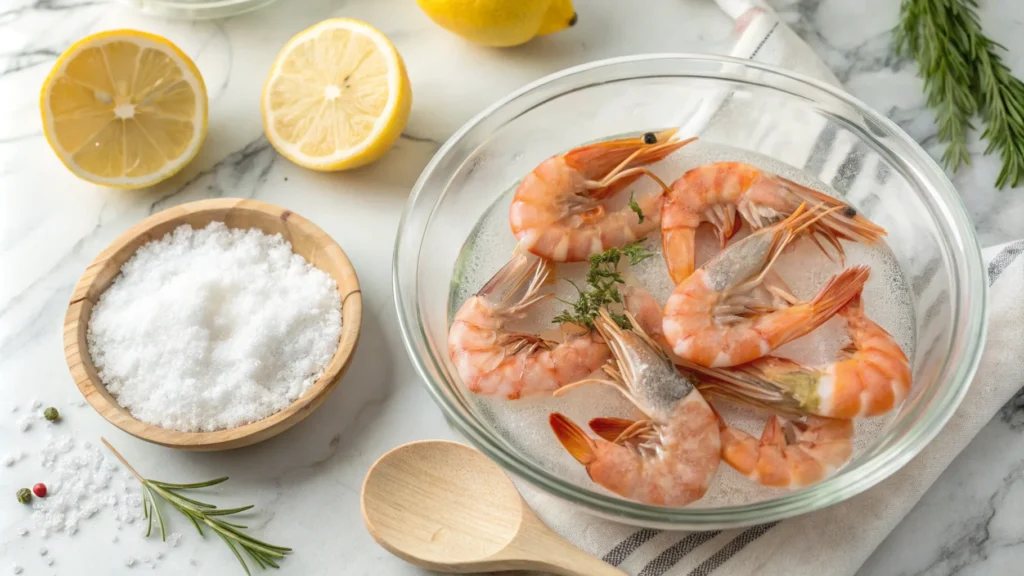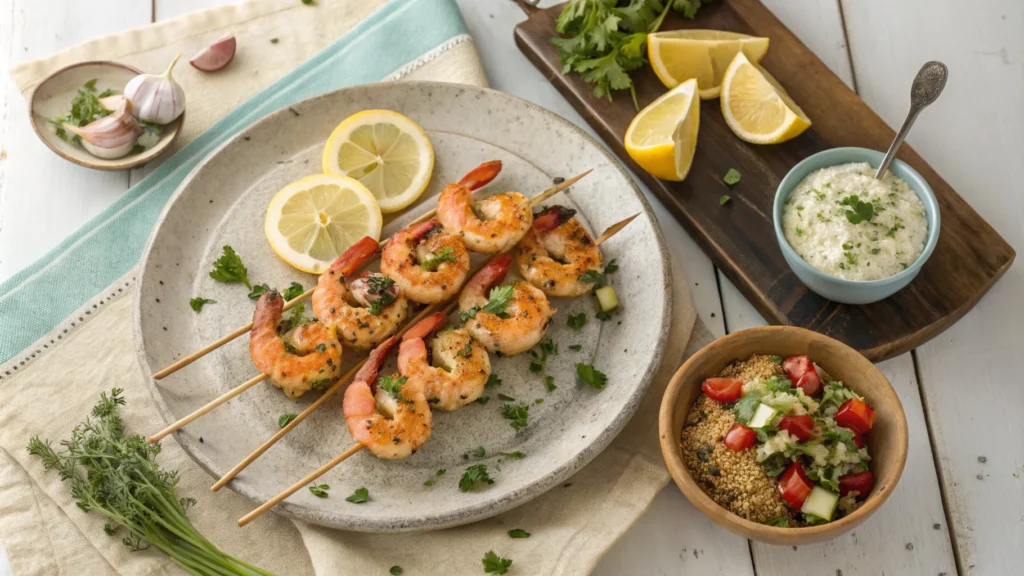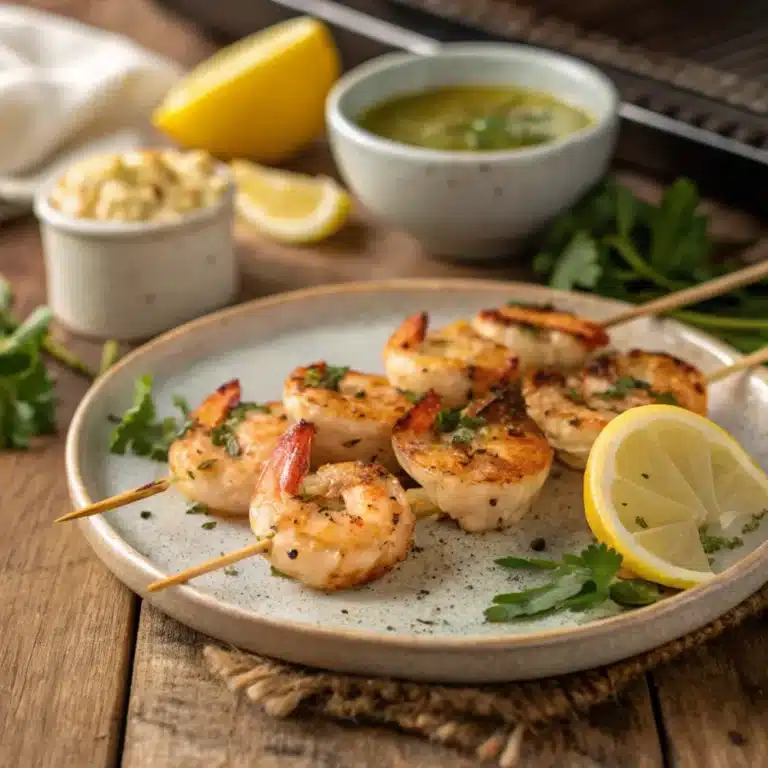How to Keep Shrimp Moist While Grilling
Grilling shrimp sounds simple, right? Unfortunately, it often ends up overcooked, rubbery, or disappointingly dry. The good news is that with a few smart tricks, you can keep shrimp moist and juicy every time it hits the grill. Whether it’s brining with salt, marinating in yogurt, or mastering the perfect timing, these strategies will make you a pro at grilling shrimp without a hitch.
In this article, we’ll cover everything you need to know—from preparation techniques to grilling methods and tools that guarantee perfect shrimp skewers. Follow along, and you’ll soon be enjoying flavorful, tender shrimp with just the right char.
Table of contents
Understanding Shrimp and Grilling Challenges
Why Shrimp Dries Out on the Grill
Shrimp is delicate—this means it cooks incredibly fast but also dries out quickly when exposed to high heat for too long. Its small size doesn’t help either. Unlike thicker cuts of meat, shrimp lacks fat and connective tissue to protect it from overcooking. Add to that, the open flame of the grill can sap moisture from shrimp in seconds.
So, what happens when shrimp dries out? It shrivels, the texture becomes tough, and the flavor dissipates. This is why understanding shrimp’s limitations is key to overcoming these grilling challenges.
Key Characteristics of Shrimp that Impact Grilling
Before you get those skewers ready, it’s essential to understand shrimp’s anatomy and how it affects grilling.
- Size Matters: Larger shrimp (like jumbo or colossal) are better for grilling because they have more surface area and retain moisture longer. Small shrimp tend to dry out faster.
- Shell On vs. Shell Off: Leaving the shells on while grilling creates a protective barrier that locks in juices. However, if you prefer shell-off shrimp for easy eating, brining and marinating are your go-to solutions.
- Fresh vs. Frozen: Fresh shrimp taste better, but properly thawed frozen shrimp can still work wonders if handled well. Always pat them dry before grilling.
By understanding these basic challenges, you can adjust your grilling methods and preparations to keep shrimp moist while grilling. In the next part, we’ll dive into the best preparation techniques that make all the difference.
Preparation Before Grilling to Retain Moisture
Benefits of Brining Shrimp with Salt and Baking Soda
When it comes to how to keep shrimp moist while grilling, brining is a game-changer. Brining involves soaking shrimp in a saltwater solution before grilling, and this simple step secures that the shrimp stay juicy and tender. Adding a small pinch of baking soda to the mix takes it up a notch.
Why does it work? Salt improves the shrimp’s ability to retain water, while baking soda improves browning. The combination allows shrimp to hold onto their moisture, even on the grill’s high heat. To try it yourself, dissolve 1 teaspoon of salt and 1/4 teaspoon of baking soda in a cup of water. Let the shrimp soak for about 20-30 minutes, then pat them dry. This quick prep step can mean the difference between rubbery shrimp and perfectly juicy skewers.

Marinating Shrimp: Yogurt, Lemon, and Other Acids
Marinating shrimp before grilling not only adds flavor but also helps keep them moist. While acidic marinades, like lemon juice or vinegar, can tenderize proteins, you need to be careful not to marinate for too long. Over-marinating can cause shrimp to turn mushy.
For the best results, opt for a mix of fat and acid, such as yogurt with lemon juice or olive oil with herbs. Yogurt-based marinades, in particular, are excellent for grilled shrimp because the fat in yogurt protects against moisture loss while the acid improves tenderness. A marinade of 15-20 minutes is more than enough to flavor and prep the shrimp.
Proper Skewer Techniques to Avoid Drying
Skewers are a practical way to grill shrimp, but did you know they also help retain moisture? Threading shrimp onto skewers allows you to cook several pieces evenly without losing them to the grill grates.
Here are a few skewer tips:
- Use Two Skewers: Thread shrimp onto two parallel skewers to keep them stable and prevent flipping mishaps.
- Soak Wooden Skewers: Soak bamboo skewers in water for 30 minutes before grilling to stop them from burning.
- Space Them Properly: Don’t overcrowd the shrimp. Leaving a small gap between each piece secures even cooking and better browning.
With proper preparation, you set yourself up for success on the grill. Next, we’ll dive into grilling techniques that guarantee juicy, flavorful shrimp.
Grilling Techniques to Keep Shrimp Moist
Controlling Heat: Medium vs. High Temperatures
One of the most common mistakes when grilling shrimp is using excessive heat. High heat may seem tempting for a quick sear, but it often dries shrimp out before they’re done. To solve this problem, aim for medium heat.
Set your grill to around 350-400°F—hot enough to cook the shrimp quickly but not so intense that they lose moisture. Cook shrimp for 2-3 minutes per side, flipping them once. Watch closely: shrimp turn opaque and pink when they’re ready. Overcooking them for even an extra minute can lead to dry, rubbery shrimp.
The Role of Sugar for Juiciness and Caramelization
Here’s a little secret for how to keep shrimp moist while grilling: sprinkle sugar lightly on the shrimp before grilling. Sugar caramelizes quickly on the grill, creating a light crust that locks in moisture. Plus, it improves the shrimp’s natural sweetness without making them overly sugary.
To use this trick, dust the shrimp with a pinch of sugar right before grilling. Combine it with your favorite seasonings or dry rub for a flavorful finish. This simple step adds a golden color and protects the shrimp’s tender interior.
Timing: The Optimal Cooking Time for Shrimp
Timing is everything when it comes to shrimp. Grilling shrimp only takes 4-6 minutes total, so don’t step away from the grill! Overcooked shrimp shrink, dry out, and lose their juicy texture.
Follow these quick pointers for perfect timing:
- Cook in Batches: Avoid overcrowding the grill to secure even cooking.
- Flip Once: Shrimp need just one flip halfway through cooking.
- Look for Visual Cues: Shrimp are done when they turn opaque, pink, and form a slight curl.
Remember, shrimp continue cooking even after being removed from the grill, so pull them off slightly earlier than you think necessary. This secures they remain tender and moist when served.
With the right heat, a touch of sugar, and perfect timing, you’ll never have to worry about dry shrimp again. In the next section, we’ll cover the tools and accessories that make grilling shrimp even easier.
Best Tools and Accessories for Grilling Shrimp
Using Grill Baskets to Prevent Shrimp from Falling
When grilling shrimp, one common frustration is watching the shrimp slip through the grates. This not only leads to wasted food but also Shatters the cooking process. Using a grill basket solves this problem perfectly. Grill baskets provide a contained space to cook shrimp evenly without losing pieces to the flames.
The beauty of a grill basket is that it allows you to toss and turn the shrimp quickly while keeping the moisture intact. Plus, cleaning up afterward is a breeze. For added flavor, lightly coat the shrimp with olive oil and seasonings before placing them in the basket.
If you don’t have a basket, a grill mat is another handy option to keep shrimp secure while cooking. Both tools secure the shrimp cook evenly and stay tender without drying out.
Skewers: Bamboo vs. Metal and How to Prepare Them
Skewers are another must-have tool for grilling shrimp. Whether you choose bamboo or metal skewers, proper preparation is essential to avoid burning and secure consistent cooking.
- Bamboo Skewers: Always soak them in water for 30 minutes before grilling. This prevents them from catching fire on the grill.
- Metal Skewers: These reusable skewers conduct heat, which helps shrimp cook from the inside. They’re also great for holding their shape.
A simple trick is to use double skewers to keep the shrimp secure and stable, making it easier to flip them. Skewers also allow you to create colorful, flavorful shrimp kabobs by threading shrimp alongside vegetables like bell peppers and onions.
For more delicious grilling tips and recipes, check out this guide on Easy BBQ Shrimp Recipe.
Expert Tips for Juicy Grilled Shrimp
Why Patting Shrimp Dry Before Cooking Helps
Moisture is critical after cooking, but before you grill, patting shrimp dry is key. Wet shrimp don’t brown properly on the grill. Excess moisture creates steam, which prevents that beautiful caramelization that seals in juices.
To prepare shrimp for the grill:
- Use paper towels to gently blot any excess water.
- Toss the shrimp lightly with oil or marinade.
- Season just before grilling for the best results.
By drying shrimp first, you give them the perfect foundation for a juicy, flavorful finish.
Basting with Butter or Oil During Grilling
Basting is a tried-and-true method for how to keep shrimp moist while grilling. As shrimp cook, brushing them with melted butter or oil helps lock in moisture and infuses them with incredible flavor. The fat acts as a barrier, protecting the shrimp from direct heat while adding richness.
For extra flavor, mix melted butter with garlic, herbs, and a splash of lemon juice. Brush the shrimp with the mixture every minute as they grill. This secures they stay juicy and absorb the buttery goodness without becoming greasy.
Resting Shrimp After Grilling to Lock in Juices
Resting isn’t just for steaks—it works wonders for shrimp, too. Pull the shrimp off the grill and let them rest for 2-3 minutes before serving. During this brief pause, the juices redistribute, ensuring every bite remains tender and moist.
To keep shrimp warm during resting, tent them with aluminum foil. Just don’t let them sit too long, as shrimp cool quickly. Serve them immediately for the best results!
For more grilled seafood ideas, you can also check out recipes like Barbecue Shrimp: Shell On or Off.
Common Mistakes to Avoid When Grilling Shrimp
Overcooking Shrimp: The Number One Culprit
If there’s one thing that ruins shrimp on the grill, it’s overcooking. Shrimp cook incredibly fast—usually in just 4-6 minutes—so it’s easy to leave them on the grill too long. Overcooked shrimp become tough, chewy, and lose their natural juiciness.
To avoid this mistake, keep a close eye on the shrimp. Once they turn opaque, pink, and curl into a C-shape, it’s time to pull them off the heat. Remember, shrimp will continue cooking slightly from residual heat. Pull them off the grill a few seconds early to secure they remain moist and tender.
If you’ve been wondering how to keep shrimp moist while grilling, timing is everything. Use a timer or watch for the visual cues to perfect your grilled shrimp every time.
Skipping Preparation Steps
Skipping essential preparation steps—like brining, marinating, or patting shrimp dry—can set you up for failure. These small tasks are the foundation for juicy, perfectly grilled shrimp.
- Brining adds moisture and prevents dryness.
- Marinating boosts flavor and creates a protective coating.
- Patting shrimp dry secures proper browning and caramelization.
Neglecting these steps often leads to shrimp that lack flavor or moisture. Taking just 20-30 minutes for prep can transform your grilling results. After all, the best way to keep shrimp moist while grilling starts long before the shrimp hit the heat.
Serving and Pairing Ideas for Grilled Shrimp
Serving Tips for Maximum Flavor
Once you’ve mastered how to grill shrimp perfectly, it’s time to serve them in a way that highlights their flavor and texture. Shrimp are best served hot off the grill, so timing is key.
For a beautiful presentation:
- Drizzle shrimp with fresh lemon juice to brighten the flavors.
- Garnish with chopped parsley, cilantro, or dill for a pop of color.
- Serve shrimp with a side of garlic butter, chimichurri, or a creamy aioli for dipping.
Shrimp can be the star of the meal or a tasty appetizer, depending on your spread. A light sprinkle of coarse salt or crushed red pepper can improve the final dish without overpowering it.

Perfect Pairings for Grilled Shrimp
Grilled shrimp pair beautifully with a variety of sides and flavors. Whether you’re serving them at a summer barbecue or as a quick weeknight dinner, here are some perfect pairings:
- Grilled Vegetables: Zucchini, bell peppers, or asparagus complement shrimp’s smoky flavor.
- Rice or Pasta: Serve shrimp over seasoned rice, a light pasta, or a quinoa salad for a hearty meal.
- Fresh Salads: Pair grilled shrimp with a crisp, citrusy salad to balance out the richness.
- Crusty Bread: Use toasted bread to soak up any leftover juices or dipping sauces.
If you’re looking for more shrimp recipes, check out this Easy BBQ Shrimp Recipe for additional inspiration.
With the right serving techniques and perfect sides, your grilled shrimp will impress everyone at the table. Up next, we’ll tackle some frequently asked questions to address common grilling concerns.
Creative Variations for Grilled Shrimp
Seasoning Ideas for Unique Flavors
Grilled shrimp is incredibly versatile, making it the perfect base for experimenting with flavors. If you’re tired of the usual lemon and garlic combo, try these creative seasoning ideas to keep shrimp moist while grilling while adding a twist:
- Mediterranean Style: Use a blend of olive oil, minced garlic, oregano, paprika, and a squeeze of fresh lemon juice.
- Cajun Kick: Coat shrimp with Cajun seasoning, a hint of cayenne, and melted butter for bold, spicy flavors.
- Asian-Inspired: Marinate shrimp in soy sauce, ginger, garlic, sesame oil, and a splash of rice vinegar. Add a sprinkle of sesame seeds for crunch.
The key is to strike a balance between seasoning and moisture. Whether you prefer a spicy, tangy, or herbal flavor profile, each marinade locks in juices and improves the grilling process.
Stuffed or Wrapped Shrimp Options
For a gourmet touch, try stuffing or wrapping shrimp before grilling. This method not only adds layers of flavor but also helps retain moisture:
- Stuffed Shrimp: Slice open jumbo shrimp and fill them with a mixture of cream cheese, herbs, and breadcrumbs. Grill until golden.
- Bacon-Wrapped Shrimp: Wrap each shrimp in a slice of bacon or prosciutto. The fat from the bacon keeps the shrimp juicy and adds a smoky flavor.
These variations are ideal for parties or special occasions when you want to serve something impressive yet easy to prepare.
Mastering Grilling Shrimp for Every Occasion
How to Scale Recipes for Large Groups
When grilling for a crowd, scaling up your shrimp recipes can feel overwhelming. But it’s simpler than you think if you plan ahead. To make sure the shrimp stays moist, follow these tips:
- Prepare in Batches: Brine and marinate shrimp in large, shallow containers to coat them evenly.
- Use Multiple Skewers: Thread shrimp onto multiple skewers to grill them faster and more efficiently.
- Cook in Stages: If you have a smaller grill, cook shrimp in stages to secure they don’t overcrowd and lose moisture.
By sticking to the right prep and cooking times, you’ll achieve consistent results, even when feeding a crowd.
Tips for Reheating Grilled Shrimp
Sometimes you’ll have leftovers, and knowing how to reheat shrimp without drying it out is essential. Whether you’re reheating shrimp for a quick lunch or adding it to another dish, these tips will keep the moisture intact:
- Stovetop Method: Heat shrimp in a skillet with a small amount of butter or oil. Cook on low heat for 2-3 minutes to rewarm gently.
- Microwave Option: Place shrimp on a microwave-safe plate with a damp paper towel on top. Heat in 10-second bursts to avoid overcooking.
- Add to Sauces: If you’re adding shrimp to pasta or curry, let them warm in the sauce for a few minutes instead of reheating separately.
When reheating, it’s crucial not to overdo it, as shrimp can quickly become rubbery. These methods secure your leftovers taste as fresh and juicy as they did the first time around.

